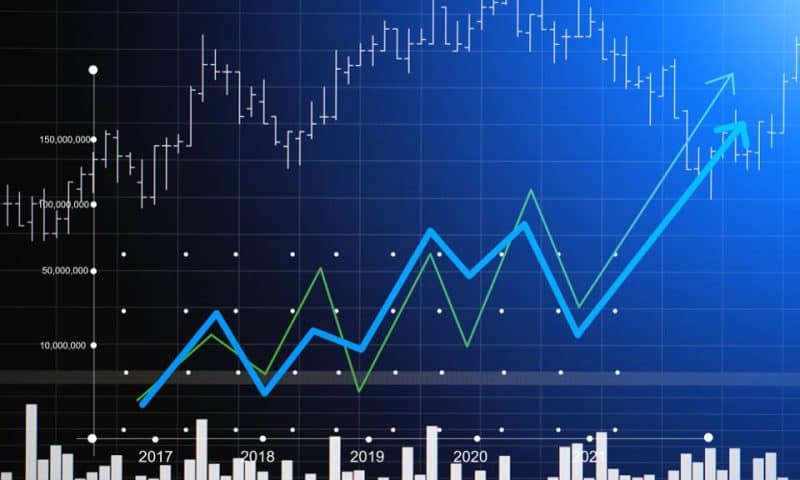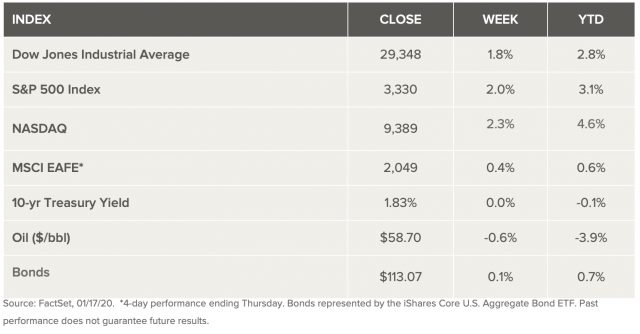5 Stocks Financial Advisors Are Watching Closely
Between January 13 and January 17, the Dow Jones Industrial Average advanced by 1.53%, while two other benchmark indexes, the S&P 500 and NASDAQ Composite appreciated by 1.26% and 1.24%, respectively. The bullish sentiment was fueled by positive economic data, the signing of the phase one trade agreement between the US and China and a strong start to the fourth-quarter earnings season.
In the US, housing starts surged by 16.9% in December, reaching a 13-year high. Retail sales advanced by 0.3% last month, which shows that the economy maintained a growth trajectory towards the end of 2019. In China, industrial production surged by 6.9% on the year last month, which represents the highest pace of growth in nine months, although the economic growth in China slowed to 6.1%, which was still in line with expectations.
The details from the US-China trade deal showed China increasing purchases of manufacturing, energy and agricultural goods and services by at least $200 billion over two years, including $77.7 billion in acquisitions of manufactured goods, $32 billion in agricultural products, $52.4 billion in energy, and $37.9 billion in services. In addition, China will submit an action plan to strengthen intellectual property protection within 30 days and will stop pressuring American companies to share technology with local joint-venture partners. However, despite signing the deal, tariffs on Chinese imports remain in place until the agreement’s second phase is completed.
Moreover, the fourth-quarter earnings season kicked off last week, with many large financial institutions, including JPMorgan Chase & Co. (NYSE: JPM) and Citigroup Inc. (NYSE: C) posting strong quarterly earnings. According to FactSet, by January 17, 9% of companies in the S&P 500 posted their results, 72% of which managed to beat earnings estimates and 63% posted better-than-expected revenues. Going forward, the expectations for the current quarter are modest, with analysts forecasting a 2% decline in profits among S&P 500 companies.
In the meantime, let’s take a look at some companies that were in the spotlight of Financial Advisors last week, according to TrackStar, InvestingChannel’s official newsletter capturing and analyzing the trends of Financial Advisors. Tesla (NASDAQ:TSLA) ranked on the first spot as the stock dipped by 2.74%. The company’s shares started the week strongly amid analysts at Jefferies boosting their price target on the stock to $600 from $400. The analysts cited strong sales from power storage and battery sales segments and expectations for the company to turn profitable. On the other hand, on Thursday Morgan Stanley cut the stock to ‘Underweight’ from ‘Equal Weight’, saying that the sustainability of the stock’s momentum is uncertain over the long-run given risks surrounding the company’s business in China, among other factors.
The second and third spot in TrackStar’s list were taken by Amazon.com, Inc. (NASDAQ: AMZN) and Apple Inc. (NASDAQ: AAPL), followed by Canopy Growth Corp (NYSE: CGC) and Eversource Energy (NYSE: ES).
In this article, let’s focus on Canopy Growth Corp (NYSE: CGC), which is a stock that rarely pops up as one of the most searched by Financial Advisors. The Canadian cannabis giant has seen its stock surge by 24% so far this year, amid a series of developments, such as the legalization of recreational sales in Illinois. Going forward, a number of states are also expected to legalize recreational sales this year, with New York, New Jersey, Connecticut and Pennsylvania among those most likely to make the move.
In the meantime, Canopy Growth is expected to report its fiscal third-quarter results. The earnings season in the cannabis industry kicked off with OrganiGram Holdings Inc (NASDAQ: OGI) last week. Organigram beat top and bottom-line estimates and its revenue more than doubled over the year. The results were seen as encouraging by investors, who in turn rushed to buy other names, including Canopy Growth.
In another development, Canopy said on Friday that it would extend the market launch of its cannabis beverages. Despite making a lot of progress in scaling the production process for the beverages in the seven weeks since it received the license in November, the scaling process is still not completed, the company said. Therefore, in order to deliver products that “meet our customers high standards”, Canopy decided to postpone the launch date of cannabis beverages. Nevertheless, the company said the delay will not have a significant impact on its revenue in fiscal 2020.





















